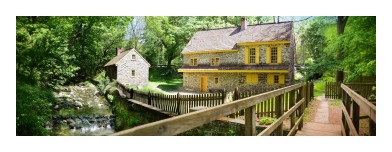208 Lincoln Drive
Philadelphia, PA 19144
United States
Rittenhouse Town Historic District
Rittenhouse Town Historic District


Located in a picturesque, steep-sided valley created by the Monoshone Creek (a tributary of the Wissahickon Creek), Rittenhousetown was the site of some of the earliest intensive industrial activity in America. Here the swift flowing waters of the creek powered the first papermill in the British colonies —and one of the first factories of any kind in the New World.
Seven buildings, constructed between 1690 and ca. l830 by successive generations of the Rittenhouse family survive today.
The enterprise was launched by William Rittenhouse (Wilhelm Rittenhausen,1644-1708), a native of Broich, Germany, where he learned the craft of paper making. Seeking religious freedom, he moved to Holland in 1663, where he continued to work in the paper industry and met the agents of William Penn, who encouraged him to emigrate to Pennsylvania. Together with his wife and children, he arrived in Germantown in 1688.
Rittenhouse partnered with Quaker printer Willam Bradford to lease a twenty-acre plot of land along the Monoshone Creek in 1690, and he immediately built a mill to produce paper, a commodity that heretofore had to be imported. At the start, the Rittenhouse family were the only papermakers in America, and they continued to dominate the industry for the next forty years.
After about a decade of operation, the first Rittenhouse mill was destroyed by a flood, but a new mill was in operation by 1703. In 1706 Rittenhouse bought out his partners to secure full ownership of the land and factory, and, when he died in 1708, these passed to his son Nicholas (Claus) Rittenhouse who carried on the paper making operation. He bequeathed it in turn to his son William, who built an additional mill, probably in 1736, and this second William Rittenhouse’s son Jacob erected yet another mill in the 1770s.
The Rittenhouse family enterprise grew and diversified, and by the end of the eighteenth century they owned and operated at least seven paper, grist, and cotton mills. By the mid-nineteenth century, papermaking was no longer their chief business, and their settlement had grown into an industrial town where hundreds lived and worked. In 1891, when the property was sold to the Fairmount Park Commission, it comprised forty structures, including six mills, a church, a school, and a fire company. All but the seven oldest buildings were then demolished in order to expand the park.
The most celebrated figure associated with Rittenhousetown was the astronomer and instrument maker David Rittenhouse (1732-1796), the great grandson of the founder. Born in the industrial village, he was a sickly child whose family moved to a farm for the sake of his health. There the astounding autodidact taught himself mathematics and astronomy and learned to make and repair clocks and other complicated instruments. He rose to prominence during the Revolution as a member of the Committee of Safety and the treasurer of the commonwealth. His scientific work was recognized by his appointment to the faculty of the College of Philadelphia (later University of Pennsylvania) and election as president of American Philosophical Society.
Today, six houses and a barn stand on the Rittenhousetown site. Dating from the late seventeenth to early nineteenth century, they reflect the gradual supplanting of German vernacular construction methods by Anglo-American stylistic fashions. Most of the structures are built of local rubble masonry, sheathed in plaster, and most have complex, multi-phase construction histories.
206 Lincoln Drive, the so-called Abraham Rittenhouse house, appears to have originally been a German style house from the first half of the eighteenth century. It was modernized in the Federal style in the early nineteenth century when the pitch of the roof was lowered and boxed cornices were installed.
207, the William Rittenhouse house, has a gable marked with the date “1707.” It is a “bank house,” with ground floor half buried in the hillside. Its windows, fireplaces, and the use of “stroh-lehm” (straw-clay) insulation reflect German influence.
207A is the earliest building in Rittenhousetown. Its original function has not been securely established, but it may be the house where Nicholas Rittenhouse's son William was born in 1691.
208 was built in the late eighteenth or early nineteenth century in a vernacular version of the Federal fashion. It was possibly constructed by Abraham Rittenhouse.
209, the largest extant house, was likely built by Jacob Rittenhouse in the late 1750s or 1760s. The mantels, balustrade, and some doors and surrounds are products of a Federal style upgrade during first decades of the nineteenth century
210 is the product of two, three, or more building campaigns in the late eighteenth and early nineteenth centuries.
210A is a bank barn (with its lower floor built into the hillside). It was part of the farm complex that includes 210. The masonry is original, but it was substantially rebuilt in the 1930s.